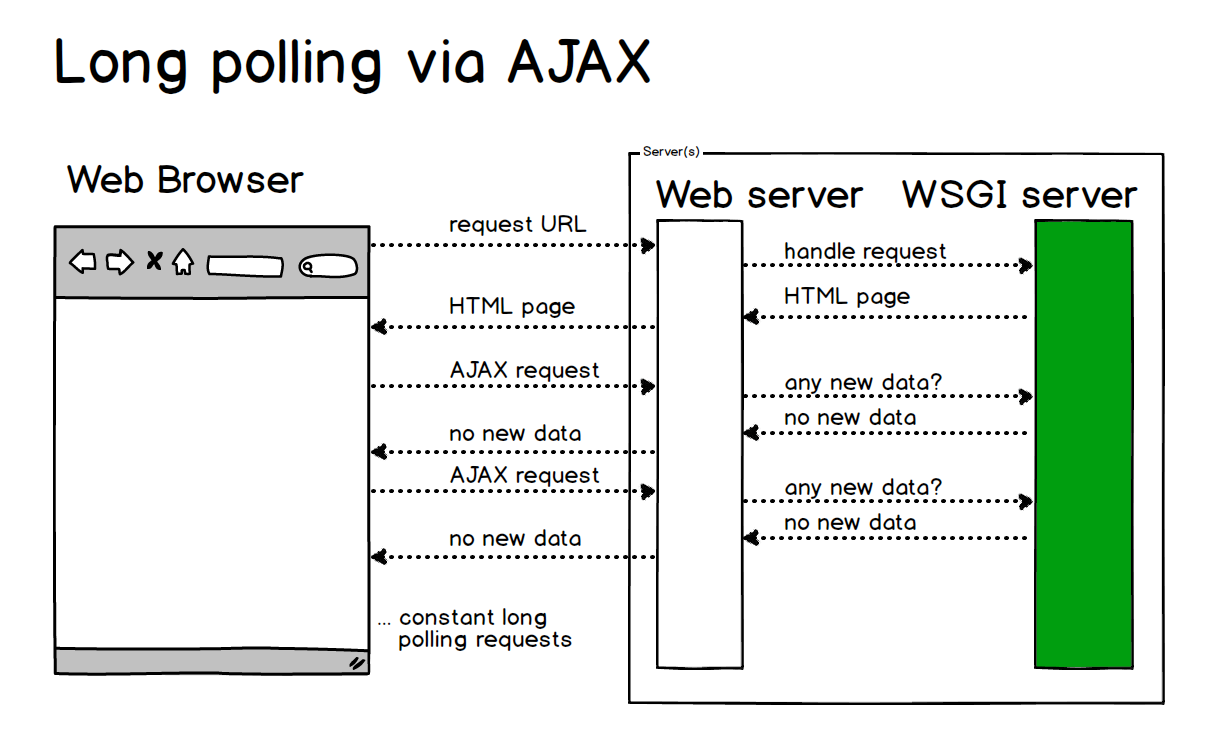WebSocket server in Python
WebSocket server in Python

Here is a comprehensive guide on setting up a WebSocket server using Python:
What are WebSockets?
WebSockets allow bidirectional real-time communication between clients and servers, enabling features like live updates, collaborative editing, and gaming. They're ideal for applications that require instant updates.
How do WebSockets work?
Handshake: The client initiates a WebSocket connection by sending aUpgrade request to the server. This triggers the server to initiate the handshake. Frame exchange: Both parties start exchanging frames, which are essentially messages with control characters (e.g., fin, rsv1, rsv2, and rsv3). Message framing: Frames contain message data, which is separated by control characters.

Setting up a WebSocket Server in Python

To set up a simple WebSocket server using Python, you'll need:
websocket-client for the client-side code (optional) autobahn library for handling WebSockets on the server side Flask or another lightweight web framework
Here's an example using Flask and autobahn:
from autobahn.asyncio import AsyncWebsocketServer
from flask import Flask, request
app = Flask(name)
class MyWebSocket(AsyncWebsocketServer):
def init(self):
super().init()
async def on_connect(self, ws, response):
print(f"Client {ws.peer_id} connected")
async def on_disconnect(self, ws):
print(f"Client {ws.peer_id} disconnected")
async def on_message(self, ws, message):
if message.startswith("Hello"):
await ws.send(message + " Server!")
if name == "main":
server = MyWebSocket()
app.route("/websocket", endpoint="websocket")(server.run)
app.run(debug=True, port=9000)
This code sets up a WebSocket server on port 9000. When clients connect and send the message Hello, the server responds with Hello Server!.
How to use this server
To test your WebSocket server:
Run the Python script. Use a WebSocket client (likewscat or ws-test) to connect to your server (e.g., wscat ws://localhost:9000/websocket). Send messages to and from the client using the client tool.
Best practices
Handle disconnections correctly. Implement robust error handling. Use a secure protocol (HTTPS) for production environments.That's it! You now have a basic WebSocket server in Python. This is just a starting point; you can customize your server to suit specific needs and add more functionality as needed. Happy coding!
Please note that this is a simplified example, and you should consider adding proper error handling, logging, and security measures for production environments.
Python websocket proxy

A WebSocket proxy written in Python! That's a fascinating project. Here's an overview of how you can implement it:
What is a WebSocket Proxy?
A WebSocket proxy, also known as a reverse proxy or a relay, acts as an intermediary between a client and a server that uses WebSockets for communication. Its primary goal is to forward messages from the client to the server while handling any issues related to network connectivity, SSL/TLS encryption, or authentication.
Why Do We Need a WebSocket Proxy?
Imagine you have a client-side application (e.g., a web browser) that connects to a WebSocket server. If this connection becomes unreliable due to network issues or the server goes down, your application will break. A WebSocket proxy can help alleviate these problems by:
Load balancing: Distribute incoming traffic across multiple servers to improve performance and scalability. Connection pooling: Manage connections between clients and servers to reduce overhead and improve reliability. SSL/TLS encryption: Encrypt communication between the client, proxy, and server for secure data transfer. ** Authentication**: Verify the identity of both the client and server before establishing a connection.Implementing a WebSocket Proxy in Python
To create a WebSocket proxy using Python, you'll need to use libraries like websocket-client (for connecting to the server) and autobahn (for creating and managing WebSockets). Here's a basic outline of how you can structure your code:
import asyncio
from autobahn.asyncio.websocket import WebSocketClientProtocol
class WebSocketProxy:
def init(self, ws_url):
self.ws_client = WebSocketClientProtocol()
self/ws_client.connect(ws_url)
async def handle_message(self, message):
Process incoming messages from the client
if message.type == 'message':
await self.send_to_server(message.data)
elif message.type == 'ping':
await self.send_pings()
async def send_to_server(self, data):
Send processed message to the original server
await self.ws_client.send(data)
async def send_pings(self):
Send pings to the client to keep the connection alive
await self.ws_client.ping()
def start_proxy(self):
asyncio.get_event_loop().run_until_complete(asyncio.gather(
self.handle_messages(),
self.start_listening()
))
async def handle_messages(self):
while True:
message = await self.ws_client.recv()
await self.handle_message(message)
async def start_listening(self):
while True:
connection = await self.ws_client.accept()
print(f"Client connected: {connection}")
Process new connections (e.g., establish a new WebSocket)
In this example, the WebSocketProxy class creates a client-side WebSocket connection to the original server. It then processes incoming messages from clients and forwards them to the original server using the send_to_server method.
To start the proxy, you'd call the start_proxy method:
proxy = WebSocketProxy('ws://original-server.com/ws')
proxy.start_proxy()
This basic implementation should give you a solid foundation for building your own WebSocket proxy in Python. You can enhance it with features like load balancing, connection pooling, and authentication to make your proxy more robust.
I hope this helps!





























